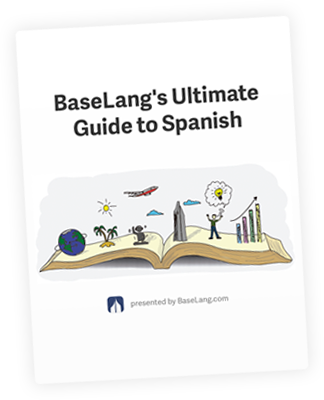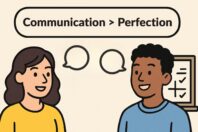How To Learn Spanish Grammar: A Simple Strategy
Get our free email course, Shortcut to Conversational.
Have conversations faster, understand people when they speak fast, and other tested tips to learn faster.
More infoGrammar is likely either your favorite subject when it comes to learning Spanish, or, like most people, it’s… scary. Let’s make one thing clear: it’s only scary because it’s easy to get confused and flustered.
And it’s only easy to get confused and flustered if you are trying to learn grammar on your own (likely with a textbook or app).
How To Approach “Grammar”
The core of the how-to aspect of learning grammar, then, is very simple.
Have your teacher teach it to you.
The reality is textbooks (or even “explained like you are five” resources) can’t answer your questions. They can’t clarify things. They present you a lot of information and aren’t much help in integrating that information into what you already know, or filtering the information by what you should bother learning now and what can wait until later.
Grammar should be explained to you by a teacher, who will be able to compare it to things you’ve already covered, know how much to teach you, and most importantly, clarify and answer questions for you until you “get it”.
Not exactly revolutionary, I know – but you don’t really care about that. You just care that it works.
Using An SRS For Grammar
During the Spanish in a Month documentary, I used flashcards for grammar as well as vocabulary. As recommended in another book, I put full sentences, fill in the blanks, etc. These, while not entirely ineffective, weren’t a great use of time.
But, I also did some simple cards just for conjugations.
For instance, instead of putting a full sentence like “I have carrots, because you gave them to me”, I just put “I have”. For instance, for the present tense of the verb Tener (to have), I simply had these cards:
- I have / tengo
- you have / tienes
- he has / tiene
- she has / tiene
- (misc object) has / tiene
- you (formal) have / tiene
- they have / tienen
- you (plural) have / tienen
- we have / tenemos
That’s it. I did this with past tenses, with irregulars, and basically any verb where I wanted to have the conjugation down cold.
This was gold.
Unlike doing full sentences, where you are exercising your translation muscles, doing it this way gives you the little building block that you can rearrange and put in any sentence. Always favor building blocks over phrases.
When it comes to conjugations, once you’ve learned a tense and a verb from your teacher (and later on, you can add regular verbs to this without their help), using an SRS like this is the fastest way to get conjugations into your head.
You still need to learn how the conjugation works from your teacher, but once you understand the mechanics, when it comes to memorizing the conjugation for each verb, this is the fastest way to do it.
In fact, each conjugated form of the verb suddenly just becomes a vocab word (and an easy one, as most verbs follow the same rules, and you’ll have several other cards for the same verb). It’s extremely efficient.
In a separate post, I wrote about the best way to learn Spanish, outlining 10 Principles that guided me to learning Spanish fast. One of these principles was using the 80/20 rule when deciding which verbs and which conjugations to memorize. The idea is that 20% of Spanish vocabulary/verbs are used 80% of the time, and so it’s best to concentrate on learning the most commonly used grammar.
But as far as doing the memorization itself, using an SRS is the fastest way.

Download the expanded guide to read later
This page gives you a great overview of the most important concepts and strategies, but for the full, expanded guide, click the button below:
Download Guide Now!Grammar Is Also Like An Onion
I like to think of Confidence as being like an onion.
You start not knowing anything. Then you learn the basics and as you become more used to speaking, eventually you are confident at those things, and your onion of confidence adds layers. Pretty soon you’re confident ordering food at a restaurant and giving directions to a taxi driver. Then you’re confident at basic conversations.
The same concept can be applied to grammar.
When you start learning Spanish grammar as a beginner, you probably start by focusing on the Present Tense. After a short period of time, you nail this tense by practicing and speaking to “solidify” it, and then you move on a new tense.
Each new conjugation, sentence form, or grammatical concept is a new layer of your onion.
So, like with confidence, as you learn, the sphere of grammar you are comfortable using increases, adding layers to the onion. First, you can say “I eat apples”, then “I’m eating an apple”, then “I was eating an apple”, then “I would have eaten an apple”.
As you build from foundational grammar (see the Perfect Spanish Curriculum Blueprint bonus for what to learn when – download that here) to advanced grammar, you are expanding your onion. What you’ll be roughly doing is…
- Learning a new concept (adding a layer)
- Practicing it in conversations to make it second nature (solidifying the layer)
- Then, once it’s second nature, adding another concept.
In the very beginning, it will be impossible to completely do step two, as you aren’t to a level of having conversations yet. Instead, this part will involve practice sentences and short exchanges with your teacher.
But as you get more and more advanced, step two will become more and more important as trying to keep adding layer after layer on a non-solid foundation is a recipe for disaster.
It’s why I only add one concept at a time, really – because I need to make sure that each new thing is solidified and second nature before moving on. Otherwise, I’ll have a hard time integrating the next new concept into what I already know, as I won’t “know” it that well. In conversations where both concepts are used at the same time, suddenly I’m having to try to learn two concepts at the same time. It’s inefficient.
Especially once you’ve achieved a conversational level, focus on one concept at a time. Solidify it through speaking and THEN work on the next concept.
You now have a framework which you can take and apply to learning grammar going forward.
This strategy for learning grammar was one of many useful strategies that you can use to copy the success I had in my “Spanish in a Month” documentary.
I’ve included all of these strategies, plus helpful tips on pronunciation, speaking like a native speaker, and more, in a 119-page guide.
You can download the entire guide, for free, below.

Download the expanded guide to read later
This page gives you a great overview of the most important concepts and strategies, but for the full, expanded guide, click the button below:
Download Guide Now!



